

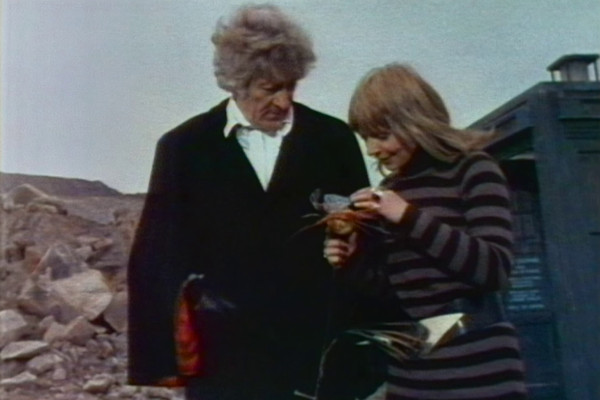
If we return to those viewing statistics, then Colony In Space is where it began to turn things around. The previous story, The Claws of Axos, averaged at 55th place/7.38 million viewers, while Colony rose to an average of 28th place/8.53 million. All of its episodes from the second onwards made the Top 30, as if people sat at home seeing Jon rolling around with green skinned aliens in a quarry and thought "It's picking up now".
Barry Letts confessed that the BBC thought Doctor Who was reaching the end of its lifespan and had planned to end the series and give him another project after Season 7 was completed. As the ratings weren't too bad, and had seen a slight increase from Patrick Troughton's final season, then they conceded to letting Barry have one more season. So you can definitely make a case that Colony In Space, where the ratings really began to improve, was instrumental in saving Doctor Who. It's a fairly amusing thought, given that Colony isn't typically a popular story amongst fans.
(If we want some laughs from the opposite direction, then it was the superb Hartnell story The Massacre that finally brought about the end to Doctor Who's original purple patch, taking a series that averaged 27th place from the first Dalek story to the end of The Daleks' Master Plan and made it into a show that averaged at 68th place for the rest of the Hartnell era.)
While Colony In Space comes fairly low down here, it's a fun watch, and some stories have to come low in rankings like this by default. It doesn't get off to a great start as it's Jo's first trip in the TARDIS and she's incredulous that it's actually able to travel... despite following a story where she'd seen it disappear with her own eyes. Having it air before The Claws of Axos would have been a better fit, though this still would have meant Jo was disbelieving of space travel when she'd seen an alien in The Mind of Evil.
However, the travelling in the TARDIS may be a key point. Although Barry Letts and Terrance Dicks liked the UNIT stories, it wasn't their idea, and the concepts of seven-parters/Earth exile that began Pertwee's run weren't theirs, but had been crafted by the previous production team for budgetary reasons. Colony In Space is the first story in two years to take viewers to an alien planet.
As a story of incident, then Colony can be slow, and ranks the lowest of its season here. But it's a pleasant enough watch, with a strong supporting cast, including Bernard Kay, who describes himself on the commentary track as a "super egoist" and takes shots at the plot holes throughout. By the final two episodes the commentary team (which also includes Katy Manning, Terrance Dicks, Michael Briant, Graeme Harper and Morris Perry) sees them spend most of the duration talking about their careers, having largely run out of things to say about the story. It's a testament that the story is a bit too long when the commentary track effectively ends before it does.
Incidentally, if you really want to know, then Troughton's final season averaged at 6.38 million/69th place, while Jon's first rose to 7.17m/60th place, and Season 8 increased to 7.96m/46th place. Aren't we all happy now we've had some more nerdy stats?
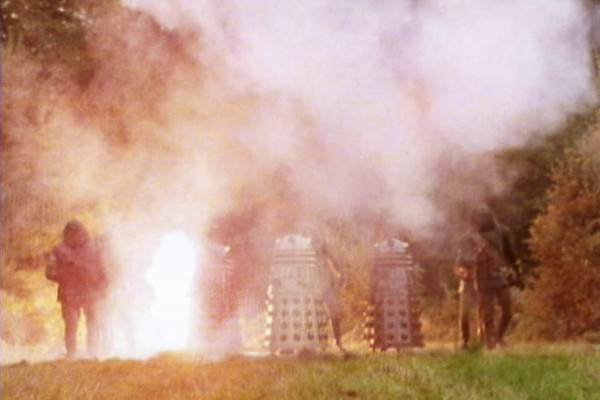
With Day of the Daleks we must look at the concept of authorship. How much of what is seen on screen is the "story", and how much is what people themselves process or adapt from the source text?
The Target novelisation of this story was the last of four that were released while Jon Pertwee was actually still the Doctor on television. (The remainder were released between late 1974-1987.) While reading through every Target book would be a large task, this particular one was read, on the suggestion that it works better on the page.
While the novel has occasional references that bulk up what was seen on screen - "Jo Grant looked from a window with horror at the advancing Dalek army" - mainly the novelisation works simply because it's all in the imagination. However, the novel has the benefit of being able to describe the thoughts of characters, giving us a more rounded Controller than that seen on television. The television serial itself was screened in 1972, then repeated as a single omnibus edition in 1973. With the serial not released on VHS until 1986, this meant all UK viewers had for over a decade was the book and the memories of older fans.
It's a decent story with a nice enough plot, though maybe never quite catches fire, and feels unusually "setty" even by the standards of the era. Yet more problematic are elements like the Doctor shooting an Ogron in cold blood, or the somewhat jarring exposition. The fact that they clearly only have three Dalek props, or that the Dalek voices aren't all that good are just surface-level details. The Dalek voices probably should be different in different stories (the mutant inside having a different larynx), but the two here are towards the bottom of the pile.
It's quite surprising how much of the Pertwee era was done without knowledge of the past - director Michael Briant had the TARDIS just appear without materialising in Colony In Space, simply because he didn't know any better, and the two actors doing the Dalek voices here were doing them staccato for the first two episodes simply because they didn't know any different, and weren't directed otherwise. Barry Letts picked up on it and changed their delivery for the second half of the story, but the two actors involved, Oliver Gilbert and Peter Messaline, perhaps get a lot of unfair stick as they can't be held personally responsible - even the ring modulation isn't right. But these are just incidental details.
Really, while it's nice if Doctor Who can hold up some kind of production values, if you're watching the programme and expecting it to have convincing special effects or slick design you're watching the wrong show. More to the point, such things are part of its charm. Yet, with this story on DVD and BluRay, there's a "special edition", which is essentially a fan edit, and something of an insult to the people who worked on the programme. Such endeavours - featuring pros, semi-pros and amateurs - are actually fairly fun to watch as fan projects, but shouldn't be on professional releases of the stories.
Imagine how you'd feel if you were one of the people who worked on the story back in the 1970s and sat down to watch the official BBC release with your family - only to find another disc with a fan edit, along with a short featurette called The Cheating Memory, explaining how crap the original was. There's also a somewhat self-aggrandising documentary on the making of the special, with Nick Briggs telling us how awful the original Dalek voices were. Briggs dubs over the voices of the Daleks for the "special edition"... the same Nick Briggs who supplies "amateur dramatics" voices for the Daleks in the new version of the series.
Attempting to "improve" things with redubs and new SFX isn't just a matter of disrespect to the source material. The issue with adding computer effects in the 2000s to archive television - apart from the fact that they're clearly made on a tight budget - is that it introduces foreign artefacts to the original material. Having somewhat rudimentary, 21st century CGI doesn't really work when you're adding it to a stories involving huge sideburns and flared trousers. Not to mention there's no real attempt to integrate the effects with the source material, they're just dubbed over the existing footage.
Often they work against the material, with the Commander's final defiant speech plastered with vision and sound effects that take unnecessary priority over the actual story itself. There's also a somewhat cloth-eared mentality towards adding the effects to everything, despite what the script might suggest. So that you can hear Jon Pertwee describing a weapon as being an ultrasonic device, then just seconds later see a visual ray coming from it.
The need to fiddle and change things comes not just with the Dalek voices and the effects, but with other elements. There's a debate as to what colour the TARDIS console was during the ‘60s within the fiction of the show, as the actual prop was pale green, but this was so it would show up in black and white. However, when the show went to colour the prop wasn't repainted, so Jon Pertwee's Doctor travelled with the pale green console. While this could have been argued to have been an oversight on behalf of the production team, it was one they went with, as a new console was made for The Claws of Axos the year before, and kept the pale green colour. Yet for some reason the "special" edition has it digitally altered to become silver.
When Doctor Who was launched on iPlayer to celebrate the 60th anniversary, it made the same mistake that Britbox did: it added the Special Edition by mistake. The original version still exists, but at date of writing you need to buy the DVD or BluRay to see it.
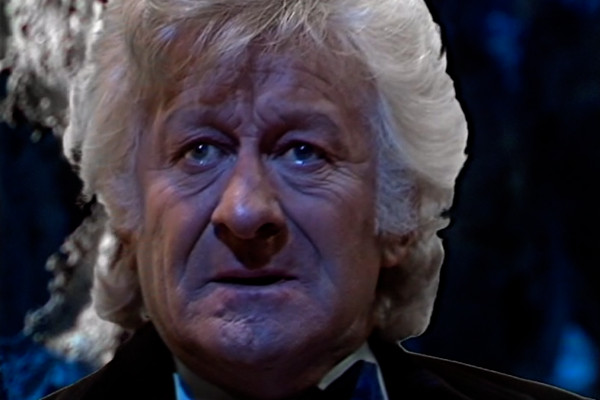
Another Anorak Zone favourite that's fallen on rewatch, you can have an objective assessment about these things: having affection for a story while still acknowledging it's not all that.
Part of the issue is that it's refreshingly ideas over rigid plot structure, but in a way that viewers perhaps aren't used to. Characters and situations are introduced, but don't tie up to some connected narrative, but instead go on dead ends.
For example, there's Tommy, the site help with learning difficulties. Tommy has his intelligence increased by looking into the Metabelis crystal, which acts as a thematic parallel of what happened to the spiders, but in terms of plot goes nowhere. Okay, it does have the plot point that it makes the spiders aware of the crystal vibrations again, but there's no real function for the character, no "pay off". Could the story have worked without him? Yes. Could the story have worked without Mike Yates? Yes. (Although it's very nice to see both of them.)
There's also the villain of the piece in the form of Lupton, an embittered middle management figure who wants revenge. We'll skip over the extended chase sequence in episode two as it was there just as a parting love letter to Jon and always gets mentioned, but Lupton ultimately does nothing except be killed.
As said, it's quite refreshing, if a little unsatisfying. It's as if the MacGuffin of the story isn't an object or plot point, but all the characters themselves. It's Chekov's Gun, but with the gun flushed down the loo. The story ultimately ends up as a Buddhist parable-cum-metaphor, and while Buddhism is a fascinating topic, it's perhaps not an ideal foundation for a science fiction story. The Doctor sacrifices himself because he must overcome his greatest fear, something that's thrown in almost as an afterthought in the penultimate episode.
The Doctor feeling genuine fear when he's controlled by a giant spider is, as pictured above, one of the more striking moments in the run, but it feels tagged on. Many of the episodes were also mistimed, causing certain scenes to be shifted around in order to ensure they made the correct length. With a very artificial cliffhanger for episode five, it has to be asked... why wasn't the spider appearing on Sarah's back the cliffhanger?
Perhaps the biggest curiosity of this story is the performance of Phyllis Blythe under her stage name Jenny Laird. Laird had worked with RADA and appeared in Shakespeare, Chekov and Ibsen - she even had an award named after her by RADA (albeit the award "achievement in a thankless role").
Somehow, despite all this, she stinks the entire place out in this story. Was it the (admittedly poor) dialogue she was given? The direction by Barry Letts? Possibly it's just that she plays the part like she's performing Shakespeare, and with the greatest of respect to Barry Letts and Robert Sloman, Shakespeare this isn't.
There's a lot to like here. It's a story I used to love. But with the slack plot, and increasing cheapness - the final UNIT HQ never looks like anything but a TV studio - it's not a greatest hits package of the run, but more of a last gasp. The Pertwee era has a lot going for it, but at this stage it was clearly time for a change.
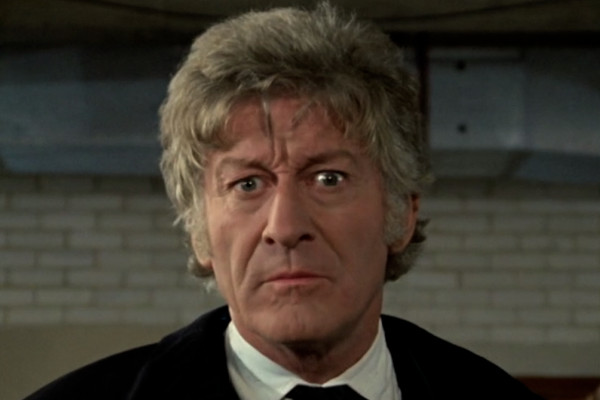
Jon Pertwee's debut story, and perhaps ranked a little too low here. Yet there's a slightly sterile, clinical feel to a lot of the story, not helped by it all being shot entirely on film because of industrial strikes. While it understandably looks better as a result, it somehow deprives the show of atmosphere.
It could be that the cast just haven't worked out their chemistry yet, though the story picks up whenever Pertwee is on screen. It certainly has its strengths, and many iconic scenes, but it could just be that the sound is little "thin" or "tinny" under the restricted budget, causing things to lack immediacy.
Both of these matters were addressed by Nicholas Courtney in Still Getting Away With It, where he acknowledged both the sound issue and an uneasy start to his working relationship with Jon: "All the UNIT Headquarters scenes were filmed in an underground car park, which produced a somewhat hollow sound effect. [...] At the beginning of Jon's era, he and I didn't find it especially easy to rub along with one another. He was still working his way into his new role and tentatively sizing me up. He always seemed to be everywhere at the same time; he had a certain mercurial quality and an extraordinary, bubbling energy, which always made him hard to pin down."
While it's natural to regard the Pertwee era of being a product of the '70s, given the bright colours and the fact that it was broadcast during that decade, this story and a sizeable part of The Silurians were actually shot in 1969. Spearhead From Space was also the only Pertwee story not produced by Barry Letts, but by Derrick Sherwin.
The serial was popular enough for them to ask for a sequel, and while many elements of Terror of the Autons are essentially retreads of this one, an element that previously passed me by also went on to inform the character of the Master - Spearhead features a man who controls people via a form of hypnosis.
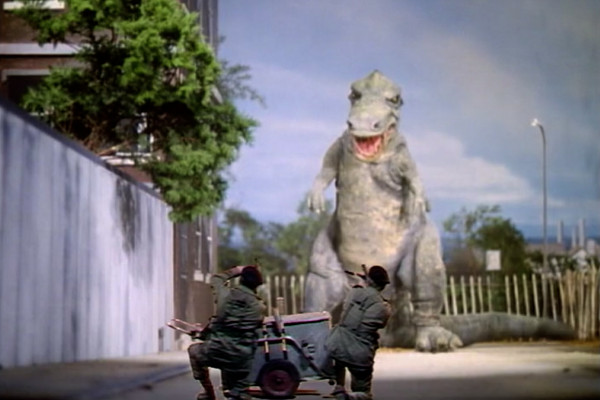
Doctor Who Magazine isn't a publication that goes in for knocking the show, but in 1988 had a light-hearted look at "25 Years of Turkeys". The choices were pretty predictable, and didn't really give much due credit to some under-regarded stories. Along with three Hartnells and three Toms, the rest of the original series Doctors, save Davison, had a story each in the list. For Jon, Invasion of the Dinosaurs came seventh.
There probably is a difference between being a Doctor Who fan, watching episodes in private for fun, and seeing the shows on a mainstream platform. It's easy to look back and enjoy a VHS knowing it's for your own personal enjoyment, but the embarrassment at watching this as it went out, knowing this was being broadcast to an average of 9.6 million people, must have been excruciating.
There's no denying the dinosaurs that appear in the story are, in the words of producer Barry Letts, "awful". They're diabolical, and it's a wonder it ever got made. From a production standpoint, it has to be the lowest the series ever sank. Yet, while you may look at the screenshot above and be in a state of abject terror at how scary it is, you might be surprised by how little they're actually on screen.
If we take the lengths of each episode, just the material only (so without the beginning and end titles, but with reprises) it comes to 140'33m. If we count the seconds of dinosaur footage, it comes to under 10 minutes throughout the entire six episodes. It may not seem like it, but take episodes four and five, where they're in it for significantly less than a minute in both. Altogether the dinosaurs account for only around 7% of the runtime, including reprised material. That's a lot of story to get through where you don't have to be distracted by poor effects.
The actual story itself, that 93%, is why this story ranks so high. Yes, the dinosaurs in Jurassic Park might be a little better (!), but even there they only appear for around 15 minutes/12% of the film - and what has the better story, this or Jurassic Park? Think of it as just trimmings, not the core story. Said core story involves a plan to reverse the world to a healthier state, along with Hulke's usual subtextual themes of racial purity, perhaps, in that the world is to be turned back "how it used to be".
As this is a six-parter, the plot does get diverted, with Sarah Jane on board what she and a colony believes is a spaceship, but is really just an underground room. It's a nice idea, though oddly similar to the group of people living underground in the false belief that the Earth is covered in radiation in the Patrick Troughton story The Enemy of the World. While it's easy to point out that the director of The Enemy of the World was Barry Letts and wonder if there's a connection as a result, Dinosaurs more likely took its inspiration from the BBC Out Of The Unknown episode "Thirteen To Centarus", which aired in 1965 and was based on a J.G. Ballard short story. Enemy, for its part, perhaps bore more similarities to Philip K. Dick's "The Penultimate Truth", but this is just speculation at this point.
The changing of Captain Yates into an unwilling traitor may seem a little extreme - and it would have been nice to have seen him before this, gradually changing - but it is implied he had a nervous breakdown after The Green Death. His next appearance was in Planet of the Spiders, where he was attached to a wellness retreat - something quite unusual then, but very much the norm now, showing how ahead of its time the show could be.
One last thing to note is that Jon Pertwee reportedly wasn't happy with Elisabeth Sladen's new bob cut, with her revealing in Elisabeth Sladen: The Autobiography that he said: "'What have you done to your hair? No, I don't like that!'" Whatever Jon's personal tastes, he kind of had a point - there was over a three month gap between recording this serial and The Time Warrior, yet this tale was supposed to take place immediately afterwards. Where did Sarah get the time to get her hair cut?
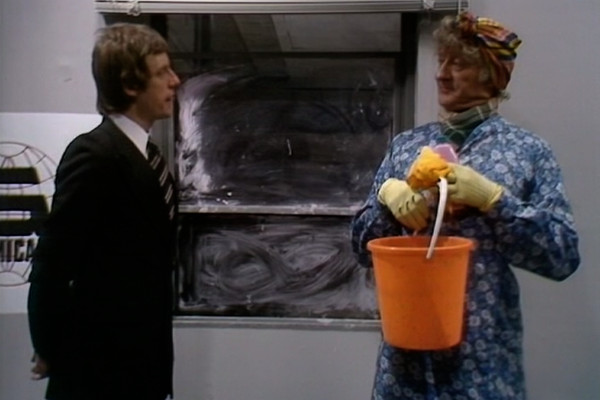
Perhaps the most perfect mix between good and bad in the entire Pertwee era, The Green Death mixes a newfound realism with abject silliness. One minute you're watching one of the greatest Doctor Who stories, the next you're watching one of the daftest - sometimes within the same scene.
The only story from the era specifically written with an "agenda", Barry Letts devised this ecological thriller and co-wrote it with Robert Sloman. As with a lot of Doctor Who of the period, many of the "science fiction" elements of the time are overlooked as they've become our reality - the world of spy cameras and interactive viewscreens for communication are no longer projections of a possible future.
Featuring an infestation of giant maggots and a living computer, the story has a nice collection of characters, including a genuine love interest for Jo in the form of Cliff Jones, played by her then real-life boyfriend. There's time for characters to take a break and indulge in real conversations, with the Brigadier puffing cigars after dinner, and Cliff's use of the word "lav" might actually be the first time a toilet was mentioned in the series.
So, it's a bit more "real" than many other stories of the period, particularly those that surround it. But it can also be a lot sillier, too. Significant, perhaps, is Jon's own description in I Am The Doctor of the episode where he disguises himself as a Welsh milkman and a cleaning lady: "I got the opportunity to play some different characters in this story. The first time was when I posed as an elderly milkman in order to get into the chemical factory. I quite liked that little piece as the character was a chatty Welsh milkman. The other part was an old cleaning lady, but I was rather less pleased with that performance. A bit OTT I thought. However, it was refreshing to get out of the character of the Doctor for a few moments and to do something else." Note that his description is playing a different character, not the Doctor himself putting on an act. However, such bits are fun.
Less fun are giant flies, singing computers, or some of the lesser effects. One prominent element of Doctor Who during this period was the extensive use of blue screen/chromakey, or, as the BBC called it, Colour Separation Overlay (CSO). It's hard to say how pivotal this era of Doctor Who was in developing the use of CSO - a great number of documentaries have said that the show was a pioneer in the technology, but most of the documentaries that say this are on Doctor Who DVDs, usually with Barry Letts himself saying it, bless him.
What can be confirmed is that CSO was used a lot during this period, with varying results, and a lot of it in The Green Death doesn't come over terribly well. Although other stories, such as Carnival of Monsters, have weak CSO, it's not as distracting because it's a fantastical story... having a more "real" story like The Green Death mixing CSO with toy car models is a little jarring.
It all ends with the Doctor heartbroken that Jo is leaving his company to marry Cliff. This element is played out not with the modern need for tears or verbalising emotion, but that little thing called understatement. The Doctor driving away in silence as the sun sets is one of the most striking moments in the whole series.
While the Doctor's reaction to Jo leaving could be taken as romantic, it's more a father figure having to give his daughter away. The problem is that the revived version of the series has pushed the concept that the Doctor is a different person each time, essentially a new entity. But while there's jokes towards this in the old series, the framework of the original show is that it's the same person, just with a different body and personality... it's still the same man. Only the outer physical form has changed.
So the Doctor can't get romantically involved with companions even if he's inside what appears to be a thirty-year-old body, as he'd still be around a thousand years older - that's some age gap. The new version of the show likes to regularly ask inappropriate questions that have never been asked before, such as: "What if people thought the Doctor's companion was an escort?" or "Does the Doctor go to the toilet?", seemingly not realising that the simple reason why these "searching questions" never got asked in the original run is because... it was a family show.